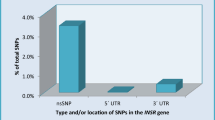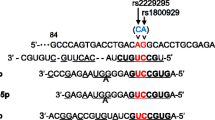Abstract
Increased levels of retinol binding protein 4 (RBP4) in serum is associated with insulin resistance. To examine this further, the genomic region of RBP4 was genetically surveyed in Mongolian people, who as a group are suffering from a recent rapid increase in diabetes. The RBP4 gene was screened by DHPLC system, and the PCR fragments which showed heteroduplex peaks in multiple samples were followed by direct sequencing to identify common polymorphisms in 48 Mongolian diabetic samples. Identified single nucleotide polymorphisms (SNPs) were genotyped in 511 control and 281 type 2 diabetes samples. The functions of SNPs in the regulatory region were assessed by reporter gene assay and electrophoretic mobility shift assay. Possible association between functional SNPs and serum RBP4 levels or metabolic parameters was statistically assessed. Nine SNPs were identified in the RBP4 gene. A case-control study revealed that the rare alleles of four SNPs were associated with increased risk of diabetes, even after Bonferroni correction (−803, G > A, P = 0.0054; +5169, C > T, P = 0.0025; +6969, G > C, P = 0.0015; +7542, T > del, P = 0.0015). The −803 G > A SNP influenced the transcription efficiency in a hepatocarcinoma cell line as well as the binding efficiency of hepatocyte nuclear factor 1 alpha to the motif. In addition, the −803 A allele was associated with increased serum RBP4 levels in diabetic patients. We have identified a functional SNP in the RBP4 gene associated with type 2 diabetes in Mongolian people.




Similar content being viewed by others
Abbreviations
- RBP4:
-
Retinol binding protein 4
- HNF1α:
-
Hepatocyte nuclear factor 1 alpha
- SNP:
-
Single nucleotide polymorphism
- EMSA:
-
Electrophoretic mobility shift assay
- LD:
-
Linkage disequilibrium
References
Arner P, Pollare T, Lithell H (1991) Different aetiologies of type 2 (non-insulin-dependent) diabetes mellitus in obese and non-obese subjects. Diabetologia 34:483–487
Banerji MA, Lebovitz HE (1989) Insulin-sensitive and insulin-resistant variants in NIDDM. Diabetes 38:784–792
Cervin C, Orho-Melander M, Ridderstrale M, Lehto M, Barg S, Groop L, Cilio CM (2002) Characterization of a naturally occurring mutation (L107I) in the HNF1 alpha (MODY3) gene. Diabetologia 45:1703–1708
Diehl AK, Stern MP (1989) Special health problems of Mexican-Americans: obesity, gallbladder disease, diabetes mellitus, and cardiovascular disease. Adv Intern Med 34:73–96
Duggirala R, Blangero J, Almasy L, Dyer TD, Williams KL, Leach RJ, O’Connell P, Stern MP (1999) Linkage of type 2 diabetes mellitus and of age at onset to a genetic location on chromosome 10q in Mexican Americans. Am J Hum Genet 64:1127–1140
Electronic version of Diabetes Atlas. Executive summary, 2nd ed. International Diabetes Federation. (2003) http://www.eatlas.idf.org/webdata/docs/Atlas%202003-Summary.pdf
Graham TE, Yang Q, Bluher M, Hammarstedt A, Ciaraldi TP, Henry RR, Wason CJ, Oberbach A, Jansson PA, Smith U, Kahn BB (2006) Retinol-binding protein 4 and insulin resistance in lean, obese, and diabetic subjects. N Engl J Med 354:2552–2563
Hiraiwa H, Pan CJ, Lin B, Akiyama TE, Gonzalez FJ, Chou JY (2001) A molecular link between the common phenotypes of type 1 glycogen storage disease and HNF1alpha-null mice. J Biol Chem 276:7963–7967
Hirasawa A, Tsumaya K, Awaji T, Katsuma S, Adachi T, Yamada , Sugimoto Y, Miyazaki S, Tsujimoto G (2005) Free fatty acids regulate gut incretin glucagon-like peptide-1 secretion through GPR120. Nat Med 11(1):90–94
Kamatani N, Sekine A, Kitamoto T, Iida A, Saito S, Kogame A, Inoue E, Kawamoto M, Harigai M, Nakamura Y (2004) Large-scale single-nucleotide polymorphism (SNP) and haplotype analyses, using dense SNP Maps, of 199 drug-related genes in 752 subjects: the analysis of the association between uncommon SNPs within haplotype blocks and the haplotypes constructed with haplotype-tagging SNPs. Am J Hum Genet 75:190–203
McKeigue PM, Shah B, Marmot MG (1991) Relation of central obesity and insulin resistance with high diabetes prevalence and cardiovascular risk in South Asians. Lancet 337:382–386
Meigs JB, Panhuysen CI, Myers RH, Wilson PW, Cupples LA (2002) A genome-wide scan for loci linked to plasma levels of glucose and HbA(1c) in a community-based sample of Caucasian pedigrees: the Framingham offspring study. Diabetes 51:833–840
Naylor HM, Newcomer ME (1999) The structure of human retinol-binding protein (RBP) with its carrier protein transthyretin reveals an interaction with the carboxy terminus of RBP. Biochemistry 38:2647–2653
Polonsky KS, Sturis J, Bell GI (1996) Seminars in medicine of the Beth Israel Hospital, Boston. Non-insulin-dependent diabetes mellitus—a genetically programmed failure of the beta cell to compensate for insulin resistance. N Engl J Med 334:777–783
Shiwaku K, Anuurad E, Enkhmaa B, Nogi A, Kitajima K, Shimono K, Yamane Y, Oyunsuren T (2004) Overweight Japanese with body mass indexes of 23.0–24.9 have higher risks for obesity—associated disorders: a comparison of Japanese and Mongolians. Int J Obes Relat Metab Disord 28:152–158
Suvd J, Gerel B, Otgooloi H, Purevsuren D, Zolzaya H, Roglic G, King H (2002) Glucose intolerance and associated factors in Mongolia: results of a national survey. Diabet Med 19:502–508
Takeda J, Kayano T, Fukomoto H, Bell GI (1993) Organization of the human GLUT2 (pancreatic beta-cell and hepatocyte) glucose transporter gene. Diabetes 42:773–777
Taniguchi A, Nakai Y, Fukushima M, Kawamura H, Imura H, Nagata I, Tokuyama K (1992) Pathogenic factors responsible for glucose intolerance in patients with NIDDM. Diabetes 41:1540–1546
Vaulont S, Puzenat N, Levrat F, Cognet M, Kahn A, Raymondjean M (1989) Proteins binding to the liver-specific pyruvate kinase gene promoter. A unique combination of known factors. J Mol Biol 209:205–219
Yang Q, Graham TE, Mody N, Preitner F, Peroni OD, Zabolotny JM, Kotani K, Quadro L, Kahn BB (2005) Serum retinol binding protein 4 contributes to insulin resistance in obesity and type 2 diabetes. Nature. 436:356–362
Zimmet P (1979) Epidemiology of diabetes and its macrovascular manifestations in Pacific populations: the medical effects of social progress. Diabetes Care 2:144–153
Acknowledgments
The study was supported by grants in aid (No.17390205 and F-27 as a center of excellence) from the Japanese Ministry of Education, Culture, Sports, Science and Technology, and a grant from the Heiwa Nakajima Foundation (Tokyo, Japan). We thank Oyamada T, Nagashima K, Oh-hashi Y, Ishikawa T, Awano A for valuable technical assistance. We thank Drs. Shinetuya D, Tsetsgee D, Munkhchimeg Ch and Batjargal Ch (Health Sciences University of Mongolia) for sample collection, and Drs. Ishibashi S and Nagasaka S (Department of Endocrinolgy, Jichi Medical School) for valuable discussion.
Author information
Authors and Affiliations
Corresponding author
Rights and permissions
About this article
Cite this article
Munkhtulga, L., Nakayama, K., Utsumi, N. et al. Identification of a regulatory SNP in the retinol binding protein 4 gene associated with type 2 diabetes in Mongolia. Hum Genet 120, 879–888 (2007). https://doi.org/10.1007/s00439-006-0264-4
Received:
Accepted:
Published:
Issue Date:
DOI: https://doi.org/10.1007/s00439-006-0264-4




